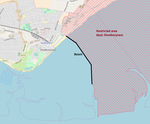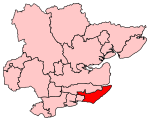Shoeburyness railway station
DfT Category E stationsFormer London, Tilbury and Southend Railway stationsRailway stations in Great Britain opened in 1884Railway stations in Southend-on-SeaRailway stations served by c2c ... and 1 more
Use British English from June 2015

Shoeburyness railway station is the eastern terminus of the London, Tilbury and Southend Line (Engineer's Line Reference FSS), serving the suburb of Shoeburyness, Essex. It is 39 miles 40 chains (63.57 km) down the main line from London Fenchurch Street via Basildon; the preceding station is Thorpe Bay. Its three-letter station code is SRY. The line and station were opened in 1884 when the London, Tilbury and Southend Railway expanded east from Southend. The station and all trains serving it are currently operated by c2c.
Excerpt from the Wikipedia article Shoeburyness railway station (License: CC BY-SA 3.0, Authors, Images).Shoeburyness railway station
Terminal Close, Southend-on-Sea
Geographical coordinates (GPS) Address Nearby Places Show on map
Geographical coordinates (GPS)
| Latitude | Longitude |
|---|---|
| N 51.531 ° | E 0.795 ° |
Address
Shoeburyness Station
Terminal Close
SS3 9BH Southend-on-Sea, North Shoebury
England, United Kingdom
Open on Google Maps








